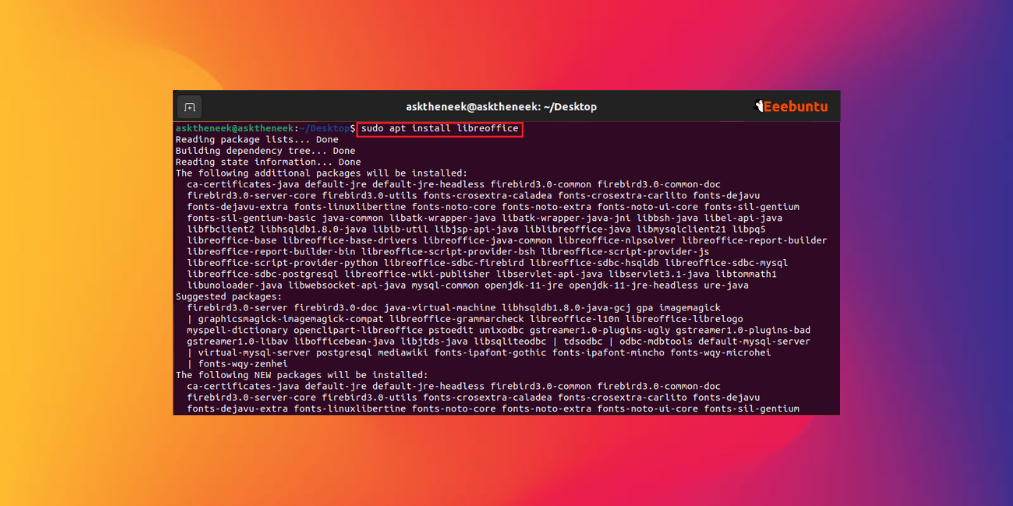Key Takeaway: LibreOffice is typically included in the default installation of Ubuntu. However, if you have chosen a minimal Ubuntu installation, replaced it with another office suite, or for any other reason it’s not present, you can easily install it by running the sudo apt install libreoffice command.
LibreOffice is a comprehensive open-source office suite that directly competes with the Microsoft Office suite, offering a range of applications for tasks like word processing, spreadsheet management, presentations, and beyond. Not only is it free, but it also boasts an array of features and tools. It excels in compatibility with various file formats and provides ample customization options to suit your needs.
Backed by a vibrant community of developers, LibreOffice is in a constant state of improvement, ensuring robust support across diverse operating systems.
Whether you’re using Linux or another platform, opting for LibreOffice could be a smart move due to its versatility and reliability.
That said, here I’ve put together a comprehensive guide to walk you through the installation process step by step.
So, without any further ado, let’s get started –
System Requirements
Before proceeding with the installation, it’s crucial to ensure that your system aligns with the necessary prerequisites for LibreOffice.
Below, I’ve outlined the minimum system prerequisites essential for a seamless installation and operation of LibreOffice:
- Linux kernel version 3.10 or higher
- glibc2 version 2.17 or higher
- Pentium-compatible PC (While a Pentium III or Athlon system will suffice, a more recent system is recommended)
- 256 MB RAM (However, it’s recommended to have at least 512 MB RAM)
- At least 1.55 GB of available hard disk space
- Gnome 3.18 or higher, with the at-spi2 1.32 package (This is required for support for assistive technology [AT] tools), or any other compatible GUI (such as KDE, among others)
Note: These requirements could differ based on the version of Ubuntu you’re running, but if your system specifications meet the below-shared list, you would most likely be able to install LibreOffice on your machine. However, it’s advisable to verify the system requirements specific to your version before proceeding.
Once you’ve confirmed that your system meets the necessary requirements, you can proceed with the installation of LibreOffice on your Linux machine using any of the methods shared below.
Install from Standard Repository
LibreOffice comes pre-installed in Linux Mint 20 and Ubuntu 20.04 standard repositories. But if you’ve removed LibreOffice from your machine for any reason, you can reinstall it by following these simple steps –
- Open the Terminal.
- Update the apt cache by entering the following command.
sudo apt update
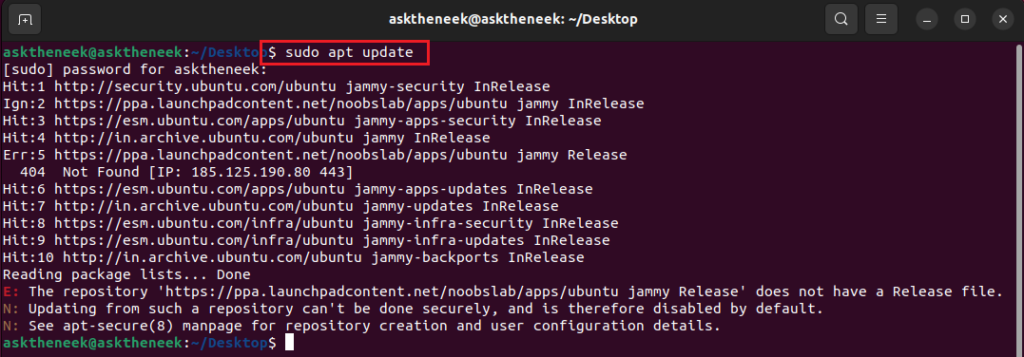
- Proceed with the installation of LibreOffice by executing the following command.
sudo apt install libreoffice
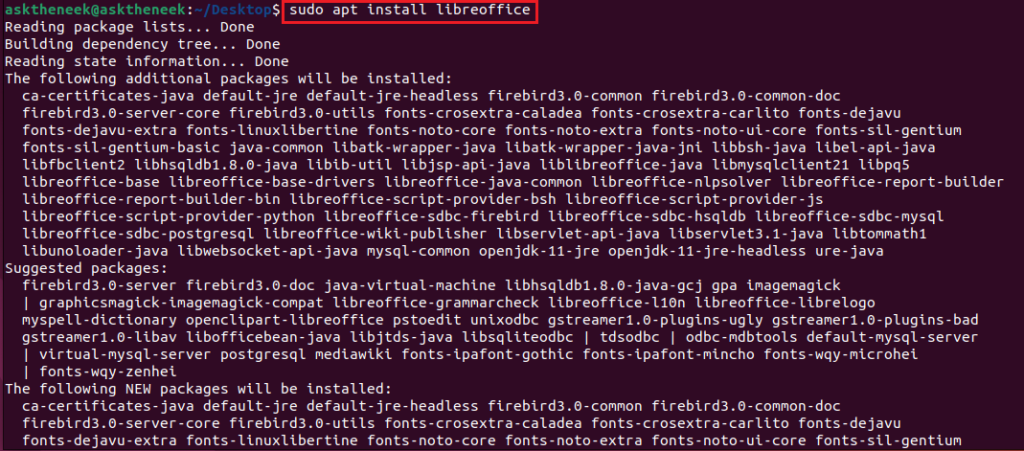
- Press ‘Y’ and then Enter to confirm and continue with the installation process.

- Once LibreOffice is installed, verify the installed version with the following command.
libreoffice --version
Install from the PPA Repository
To add the LibreOffice PPA repository and install LibreOffice on your system, follow these steps –
- Open the Terminal.
- Add the LibreOffice PPA repository by executing the following command.
sudo add-apt-repository ppa:libreoffice
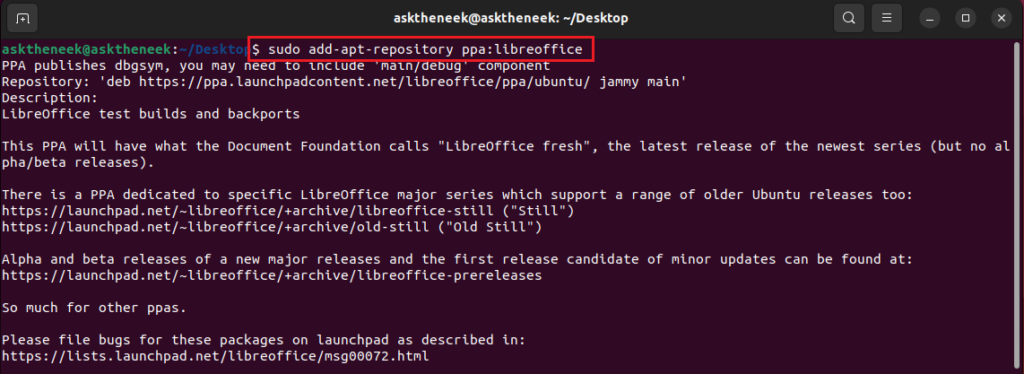
- Press Enter to confirm adding the LibreOffice PPA repository.
- Update the system’s apt repository cache by executing the following command.
sudo apt update - Install LibreOffice by executing the following command.
sudo apt install libreoffice

- Press Y and then Enter to confirm and proceed with the installation from the PPA repository.
Install from Snap
Snap is an application manager developed by Canonical that comes pre-installed with Ubuntu 20.04, but Linux Mint 20 blocks snap by default.
The good thing is that you can install and enable Snap on Linux Mint 20 easily by removing the nosnap.pref file by executing this command sudo rm /etc/apt/preferences.d/nosnap.pref
After removing the file, you can follow the following steps to install LibreOffice via Snap –
- Update the apt cache and install snap with these commands.
sudo apt update sudo apt install snapd

- Once Snap is installed, execute the following command to install LibreOffice via Snap.
sudo snap install libreoffice

- Lastly, you can verify the installation by running these commands.
snap info libreoffice
Install from the Ubuntu Software Center
These methods all rely on command-line instructions to install LibreOffice. However, if you prefer a graphical user interface, you can use the following steps –
- Open the Ubuntu Software Center.
- Search for the LibreOffice app.
- Select the LibreOffice application from the search results.
- Click on the Install button.
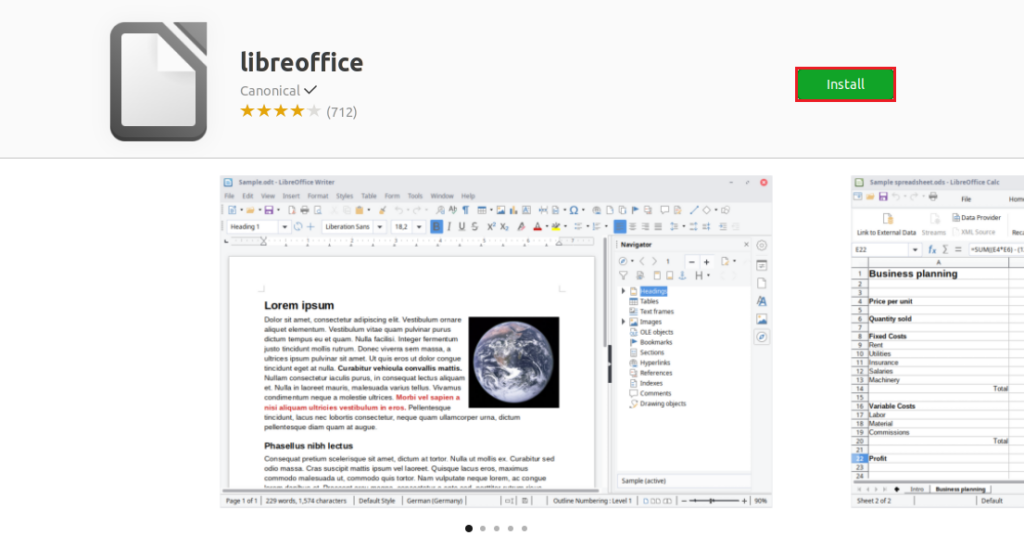
- It may ask you for authentication. If it does, authenticate it by entering your password.
- Once done, the installation process will begin.
Install using Flatpak
Flatpak is another universal package manager, similar to Snap, that hosts various applications like LibreOffice on Flathub.
However, Flatpak doesn’t come pre-installed on Ubuntu, meaning you need to manually install Flatpak on your machine before installing LibreOffice.
Here is how you can do that –
- First of all, launch the Terminal.
- Install Flatpack by executing the following command.
sudo apt install flatpak
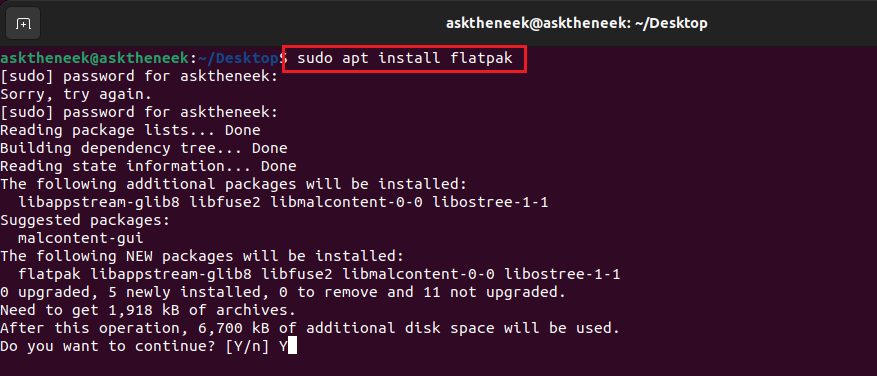
- It will ask you to enter your password and confirm you want to install Flatpak. Simply enter your password and type Y and hit Enter to proceed further.
- Next, add the Flathub repository to your machine by executing the following command.
sudo add-apt-repository ppa:alexlarsson/flatpak - After that, update the package list by executing the
sudo apt updatecommand. - Next, install Flatpak and its dependencies by executing the following command.
sudo apt install flatpak gnome-software-plugin-flatpak - Execute the following command to install LibreOffice on your Ubuntu machine.
flatpak install --user --bundle LibreOffice.flatpakref
This is how you can easily install LibreOffice using flatpack.
Additional Information
Here are a few additional information that you may need to know –
- The
--userflag installs LibreOffice in your user space, avoiding system-wide interference. - The
--bundleflag automatically installs dependencies. - For alternative repositories or versions, visit https://flathub.org/apps/org.libreoffice.LibreOffice.
- Flatpak applications are sandboxed, so they may require additional permissions sometimes. Grant them when prompted.
Install via Deb Package
LibreOffice offers an official Debian package tailor-made for Ubuntu, allowing for a direct installation of the latest version without relying on third-party tools.
To get started, visit the LibreOffice Download page and select the appropriate OS version for your system architecture (32-bit or 64-bit), along with your desired LibreOffice version. Download the provided .deb file, which comes bundled with a .tar.gz archive.
Once downloaded, navigate to the directory where the files are saved and execute the following commands in sequence. These commands will extract the tar file and seamlessly install LibreOffice.
$ tar zxvf LibreOffice_7.4.4.2_Linux_x86-64_deb.tar.gz $ cd LibreOffice_7.4.4.2_Linux_x86-64_deb/ $ cd DEBS/ $ sudo dpkg -i *.deb
Install Using Appimage
You can bypass traditional installations altogether and utilize LibreOffice directly by downloading its AppImage.
An AppImage bundles all necessary files and dependencies required to run an application seamlessly.
For this, follow these simple steps –
- Head over to the official site and download the “Fresh” Basic version of LibreOffice. If you require support for additional languages beyond English (US), other versions like Standard and Full are also available.
- Once downloaded, navigate to the location of the AppImage in your file manager.
- Right-click on the AppImage file and select the ‘Properties’ option.
- In the Properties window, head over to the Permissions tab and check the box labeled ‘Allow executing file as program.’
- Lastly, to launch LibreOffice, simply right-click on the AppImage icon and select the option to run it as a program.
Why choose LibreOffice?
LibreOffice stands out as a comprehensive, open-source office suite, delivering a plethora of robust features across various applications, including word processing, spreadsheets, presentations, and more.
Noteworthy features of LibreOffice include:
- A full-fledged suite comparable to premium offerings such as MS Office.
- Inclusion of drawing programs for tasks like creating flow charts and shapes.
- Compatibility with the Microsoft Office suite, ensuring seamless document interchangeability.
- The ability to edit PDFs, a feature absent in even Microsoft Word.
- Continuous maintenance and updates driven by a vibrant and active community.
- Cross-platform compatibility, making it an ideal alternative to Microsoft Office across all operating systems.
Pros of LibreOffice
- Open-source and freely available
- Cross-platform availability
- Seamless compatibility with diverse office suite file formats
- A full suite encompassing various applications
- Ongoing updates and robust community backing
Cons of LibreOffice
- Users transitioning from other office suites may experience a learning curve
- Lack of advanced features compared to proprietary options
- The user interface is less refined
- Lack of thorough documentation and support resources
Take into account these advantages and disadvantages to assess if LibreOffice meets your requirements and personal preferences.
Conclusion
There you have it – a detailed article on how to install LibreOffice on Ubuntu and other Linux distros.
LibreOffice undergoes regular testing to ensure it delivers the best to users. It is also recognized as one of The Document Foundation‘s most impactful Open Source initiatives, helping it thrive with community support.
With that said, here I am wrapping up this article. I hope it was a helpful read for you. If you have any questions, feel free to shoot them in the comment section below.

